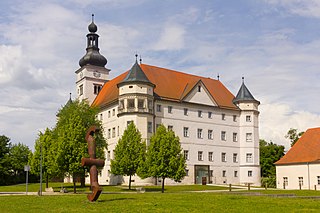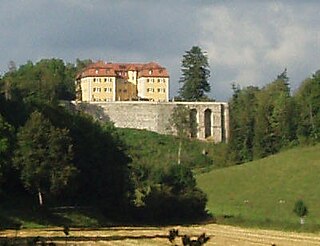
Aktion T4 was a campaign of mass murder by involuntary euthanasia in Nazi Germany. The term was first used in post-war trials against doctors who had been involved in the killings. The name T4 is an abbreviation of Tiergartenstraße 4, a street address of the Chancellery department set up in early 1940, in the Berlin borough of Tiergarten, which recruited and paid personnel associated with Aktion T4. Certain German physicians were authorised to select patients "deemed incurably sick, after most critical medical examination" and then administer to them a "mercy death". In October 1939, Adolf Hitler signed a "euthanasia note", backdated to 1 September 1939, which authorised his physician Karl Brandt and Reichsleiter Philipp Bouhler to begin the killing.

Ernst Klee was a German journalist and author. As a writer on Germany's history, he was best known for his exposure and documentation of medical crimes in Nazi Germany, much of which was concerned with the Action T4 or involuntary euthanasia program. He is the author of "The Good Old Days": The Holocaust Through the Eyes of the Perpetrators and Bystanders first published in the English translation in 1991.
Hans Heinze, sometimes referred to as Euthanasie-Heinze, was a Nazi German psychiatrist and eugenicist.
Werner Catel, Professor of Pediatrics at the University of Leipzig, was one of three doctors considered an expert on the programme of euthanasia for children and participated in the Action T4 "euthanasia" programme for the Nazis, the other two being Hans Heinze and Ernst Wentzler.

Hermann Paul Nitsche was a German psychiatrist known for his expert endorsement of the Third Reich's euthanasia authorization and who later headed the Medical Office of the T-4 Euthanasia Program.

Schloss Hartheim, also known as Hartheim Castle, is a castle at Alkoven in Upper Austria, some 14 kilometres (9 mi) from Linz, Austria. It was built by Jakob von Aspen in 1600, and it is a prominent Renaissance castle in the country.

The Grafeneck Euthanasia Centre housed in Grafeneck Castle was one of Nazi Germany's killing centres as part of their forced euthanasia programme. Today, it is a memorial site dedicated to the victims of the state-authorised programme also referred to since as Action T4. At least 10,500 mentally and physically disabled people, predominantly from Bavaria and Baden-Württemberg, were systematically killed during 1940. It was one of the first places in Nazi Germany where people were killed in large numbers in a gas chamber using carbon monoxide. This was the beginning of the Euthanasia Programme. Grafeneck was also the central office of the "Charitable Ambulance Transport GmbH" (Gekrat), which was headed by Reinhold Vorberg and responsible for the transport of T4.
Werner Blankenburg was a high official in Nazi Germany who led the commission of numerous crimes against humanity. As section head in Hitler's chancellery, he was one of the persons mainly responsible for the Aktion T4 euthanasia program, the annihilation of the Polish Jews in "Aktion Reinhard", and the experiments with castration by X-rays in the Auschwitz-Birkenau concentration camp.
August Becker was a mid-ranking functionary in the SS of Nazi Germany and chemist in the Reich Security Main Office (RSHA). He helped design the vans with a gas chamber built into the back compartment used in early Nazi mass murder of disabled people, political dissidents, Jews, and other "racial enemies", including Action T4 as well as the Einsatzgruppen in the Nazi-occupied portions of the Soviet Union. Generally his role was to provide important technical support, but on at least one occasion he personally gassed about 20 people.

Action 14f13, also called Sonderbehandlung14f13 and Aktion 14f13, was a campaign by Nazi Germany to murder Nazi concentration camp prisoners. As part of the campaign, also called invalid or prisoner euthanasia, the sick, the elderly and those prisoners who were no longer deemed fit for work were separated from the rest of the prisoners during a selection process, after which they were murdered. The Nazi campaign was in operation from 1941 to 1944 and later covered other groups of concentration camp prisoners.

The Gemeinnützige Krankentransport GmbH was a subdivision of the Action T4 organization. The euphemistically named company transported sick and disabled people to the Nazi killing centers to be murdered under the Nazi eugenics program and was known for the gray buses it used. The many victims were murdered in sealed gas chambers with carbon monoxide gas supplied in metal gas cylinders, and fed through false spray heads appearing to be shower heads. The programme Aktion T4 was managed by Viktor Brack, who was tried for his crimes at Nuremberg, and executed as a result. The operation was ordered by Adolf Hitler in early September 1939, and organized by Philip Bouhler and Karl Brandt of the Reich Chancellery.

The Sonnenstein Euthanasia Clinic was a Nazi killing centre located in the former fortress of Sonnenstein Castle near Pirna in eastern Germany, where a hospital had been established in 1811.

Gottlieb Hering was an SS commander of Nazi Germany. He served in Action T4 and later as the second and last commandant of Bełżec extermination camp during Operation Reinhard. Hering directly perpetrated the genocide of Jews and other peoples during The Holocaust.

The Hartheim killing centre was a killing facility involved in the Nazi programme known as Aktion T4, in which German citizens deemed mentally or physically unfit were systematically murdered with poison gas. Often, these patients were transferred from other killing facilities such as the Am Spiegelgrund clinic in Vienna. This was initially a programme of "involuntary euthanasia" permitted under the law ostensibly to enable the lawful and painless killing of incurably ill patients; these murders continued even after the law was rescinded in 1942. Other victims included Jews, Communists and those considered undesirable by the state. Concentration camp inmates who were unfit for work, or otherwise deemed troublesome, were also executed here. The facility was housed in Hartheim Castle in the municipality of Alkoven, near Linz, Austria, which now is a memorial site and documentation centre.

The Brandenburg Euthanasia Centre, officially known as the Brandenburg an der Havel State Welfare Institute, was a killing centre established in 1939 as part of the Nazi euthanasia programme, known after the war as "Aktion T4". Nearly 10,000 people were murdered there during its operation, primarily those with mental and physical disabilities.

The Nazi Euthanasia Centre at Bernburg operated from 21 November 1940 to 30 July 1943 in a separate wing of the State Sanatorium and Mental Hospital in Bernburg on the River Saale in the German state of Saxony-Anhalt. It was one of several euthanasia centres run by the Nazis under their official "Euthanasia Programme", later referred to after the war as Action T4. A total of 9,384 sick and handicapped people from 33 welfare institutions and nursing homes as well as around 5,000 prisoners from six concentration camps were killed there in a gas chamber using carbon monoxide gas.
Child Euthanasia was the name given to the organized killing of severely mentally and physically disabled children and young people up to 16 years old during the Nazi era in over 30 so-called special children's wards. At least 5,000 children were victims of the program, which was a precursor to the subsequent murder of children in the concentration camps.
Richard von Hegener was a primary organizer of the Nazi German "euthanasia" program within Hitler's Chancellery. After the war, he gave evidence against other participants in the program.
Carl-Heinz Rodenberg, sometimes known as Karl-Heinz Rodenberg was a German neurologist and psychiatrist. Rodenberg was proficient in the murder of mental patients by the Nazis, the Action T4 "euthanasia" program, and from 1943 was scientific director of the Reich Central Office for the Combating of Homosexuality and Abortion.
Dasein ohne Leben – Psychiatrie und Menschlichkeit is a 1942 Nazi propaganda film about the physically and mentally disabled. The film labeled inherited mental illness as a threat to public health and society, and called for extermination of those affected.











